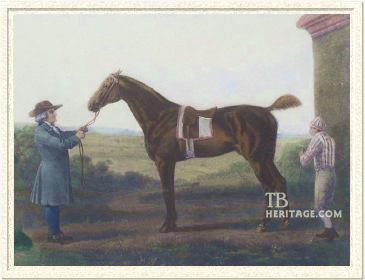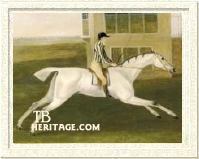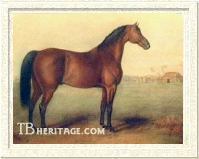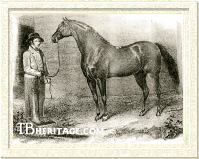|
|
Diomed

|
|
 |
|
|
Diomed is one of the most noteworthy horses on both sides of the Atlantic. He was the winner of the very first Epsom Derby in 1780, and in later life he was exported to America to become the premier sire there, leaving a dynasty that was to last for generations down through the great era of Lexington in the last half of the 1800s.
Diomed was bred by the Honorable Richard Vernon of Newmarket and sold to Sir Charles Bunbury, president of the Jockey Club in England, for whom he raced. Diomed was considered a special colt as a three-year-old, perhaps the best since Eclipse of a decade before. He was unbeaten in seven starts at three, including the first running of a stakes held at Epsom named for Lord Derby which was later to become England's premier classic race, the Epsom Derby. He came back again at four, extending his winning streak to ten races, then was beaten for the first time by Fortitude at Nottingham, and the next time out, beaten again at Newmarket by Boudroo.
After this taxing campaign, he was freshened and then put back in training. Although he forfeited a race to Crop at five, he did not race again until the following year at the age of six. He returned, but without his former brilliance. His first race back in 1783 was a victory in a King's Plate (4-mile heats at Guildford) carrying 168 pounds. He was beaten in his next start, the Craven Stakes, by Alaric, and beaten in six more races before coming up lame in a race at Winchester, at which point Bunbury retired him to stud.
Due to his tarnished reputation, Diomed's initial fee was a low 5 guineas (about $25), standing first at Up Park Stud in Hampshire and later at Barton, Suffolk. He was modestly successful, and his fee was upped to 10 guineas in 1789. His best runner sired in England was Bunbury's good colt GREY DIOMED (gr.c. 1785) which the GSB notes "was sent to Russia, where he ran with success; afterwards several of his brothers were bought for that country." Diomed also sired three useful daughters, Young Giantess, Fanny, and Young Noisette. Young Giantess produced a notable brood which included the Derby and Oaks winner Eleanor (dam of the sire Muley), Sorcerer (an important sire of the early 1800s), and two sisters to Eleanor which between them produced Derby winners Priam and Phantom, and 2000 Guineas winner Antar. Fanny produced St. Leger winner Fyldener, besides the sires Sir Oliver and Amadis. Young Noisette produced the stallion Marmion.
But interest in Diomed as a sire waned. Several of his sons displayed temperament problems, stubborness and excitibility. Along with this, his fertility had begun to decline, and his fee fell as low as 2 guineas. In 1798, Bunbury sold the 21-year-old stallion to the partners Mr. Lamb and Mr. Younger, the price 50 guineas. That same spring, two Virginian horsemen were looking for stallions to bring to America on speculation. Colonel John Hoomes of Bowling Green, and John Tayloe III of Mount Airy sent notice through their English agent, James Weatherby (of General Stud Book fame) to inquire about Diomed. Weatherby responded negatively, informing them that the old horse was a "tried and proven bad foal-getter". There being a ready market for blooded stallions in America, Hoomes and Tayloe were not disuaded, and purchased the horse at a quick profit to Lamb and Younger of about 1000 guineas.
Although it was the middle of the breeding season, Diomed was immediately put on a boat to America and his new owners wasted no time in recouping their investment. He therefore had the distinction of being one of the few stallions to have covered mares in England and America in the same season. Replacing Hoomes' deceased stallion Cormorant, Diomed stood his first season at Bowling Green, with Tayloe's patronage. In the fall of 1798 he was sold to Colonel Selden (and later a partner Thomas Goode) for a price reported to be at least six times the original investment. He stood the next two years at Goode's stud in Chesterfield, Virginia and as was the custom of the time, moved from farm to farm over the course of his career, largely in the Roanoke Valley of Virginia. In the end, he came back into the ownership of Col. Hoomes, and died at Bowling Green in 1808 at the age of 31. He was considered a national hero, and his death was widely mourned.
|

Grey Diomed

Sir Archy

Duroc
| |
What is amazing is that the aging, infertile Diomed, apparently in robust enough health to survive the Atlantic crossing, took a new lease on life in his adopted country. Not only did his fertility improve, but the quality of his offspring proved utterly revolutionary. His best runner was SIR ARCHY, bred by Tayloe and considered America's first great racehorse. Sir Archy himself became a legendary sire, his best foals included Sir Charles and Bertrand, racing champions who vied for the leading sire title for many years, as well as (Sir) Henry, Timoleon (sire of Boston), Lady Lightfoot, Flirtilla, and numerous others.
Diomed's other top runners included BALL'S FLORIZEL, POTOMAC, STUMP-THE-DEALER, DUROC (sire of American Eclipse), WILKES WONDER (sire of Tennessee Oscar and Bet Bosley), CENTINEL, PEACEMAKER, TOP GALLANT, OLD FLIRTILLA, VINGT'UN, but the most memorable of all after Sir Archy was a slight filly from his last crop of foals. Haynie's MARIA was foaled in 1808, conceived when her sire was 30 years of age.
In the first quarter of the 1800s, it was not unusual for a runner to be closely inbred to Diomed. One of his best grandsons, Sir Henry, was by his son Sir Archy and out of a daughter of Diomed. Through Sir Archy's son Timoleon, and Timoleon's great champion son Boston, his blood came to Kentucky. Boston, in turn, sired the champion racehorse Lexington, who became the leading sire in America for 18 years, and whose sons and daughters dominated racing and breeding up to the turn of the century.
|
|
The portrait of Diomed by Sartorious that hangs in the Jockey Club in Newmarket, England shows him to have been a chestnut with a star between his eyes and two white legs. He had a stockinged left hind and a left front ankle, with a spot of white on his right front coronet. Trevathan, no doubt relying on the Stubbs painting above, described him somewhat differently "He was a fine, clear chestnut, without white, except for a small touch on one of his hind heels, scarcely perceptible." Trevathan also noted he was "about 15 hands three inches high; a little dish-faced; rather straight in the hocks, and bent a little too much in his hind fetlocks." |
| Diomed's Race Record |
| Year |
Age |
Starts |
Wins |
Seconds |
Thirds |
Forfeits Paid |
| 1780 |
3 |
7 |
7 |
-- |
-- |
1 |
| 1781 |
4 |
5 |
3 |
2 |
-- |
-- |
| 1782 |
5 |
-- |
-- |
-- |
-- |
1 |
| 1783 |
6 |
8 |
1 |
3 |
3 |
-- |
| TOTAL |
-- |
20 |
11 |
5 |
3 |
2 |
1780, at 3
Won - Newmarket, second spring meeting, sweepstakes of 500 guineas each, defeating Antagonist, Diadem, and Savannah.
Won - Epsom, May 4, Derby Stakes, 50 guineas each, 1 mile, defeating Boudroo, Spitfire, Wotton, drone, Polydore, diadem, Bay bolton, a Gimcrack colt.
Won - Newmarket, July meeting, walked over, sweepstakes of 100 guineas each (7 subscribers).
Won - Newmarket, first October meeting, Tuesday, sweepstakes of 100 guineas each, received forfeit from 4.
Won - Newmarket, first October meeting, Wednesday (the day after the above race), Perram Plate, defeating Rover, Marigold, John-a-Nokes, King William, Catch, Geneva, 4 others.
Won - Newmarket, first October meeting, Friday, received forfeit from 1.
Won - Newmarket, second October meeting, won a subscription of 20 guineas each, defeating Tetotum, Dutchess, Florus, Aladdin.
1781, at 4
Won - Newmarket Craven Meeting, received forfeit.
Won - Newmarket, first spring meeting, Saturday, Fortescue Stakes, defeating Spitfire, King William, Oculator, Urtica, Commis.
Won - Newmarket, second spring meeting, Monday, Claret Stakes, defeating Antagonist, Arske, Bishop Blaze, Rodney, Diadem, Oculator.
2nd - Nottingham, defeated by Fortitude.
2nd - Newmarket, October, defeated by Boudroo.
1782, at 5 - did not start
paid forfeit to Crop
1783, at 6
Won - Guildford, June 10, king's plate, 4 mile heats, defeating Lottery.
Btn - Newmarket, Craven Stakes, won by Alaric.
Btn - Newmarket, first spring meeting, plate defeated by Laburnum and Drone.
Btn - Newmarket, first spring meeting, king's plate, defeated by Drone.
Btn - Ascot Heath, defeated by Soldier, Oliver Cromwell.
Btn - Winchester, king's plate, defeated by Anvil.
Btn - Lewes, king's plate, defeated by Mercury, Diadem.
Btn - Winchester, pulled up lame.
--Anne Peters
|
|
|
|

